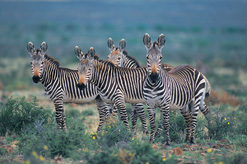
South Africa’s National Parks
South Africa has a vast system of natural reserves established to protect the country’s indigenous plants, animals, landscapes and associated cultural heritage, ranging from the vast flagship Kruger National Park – occupying an area larger than Swaziland – to the tiny Bontebok National Park in the Western Cape. These are managed by South Africa National […]

South Africa has a vast system of natural reserves established to protect the country’s indigenous plants, animals, landscapes and associated cultural heritage, ranging from the vast flagship Kruger National Park – occupying an area larger than Swaziland – to the tiny Bontebok National Park in the Western Cape.
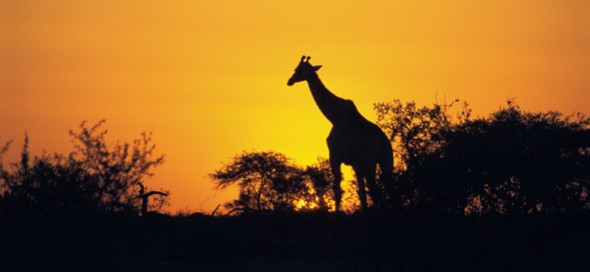
These are managed by South Africa National Parks, established by the government in 1926 and one of the world’s leading conservation and scientific research bodies.
Sections in this article:
- Introduction
- Addo Elephant National Park
- Agulhas National Park
- Augrabies National Park
- Bontebok National Park
- Camdeboo National Park
- Golden Gate National Park
- Karoo National Park
- Kgalagadi Transfrontier Park
- Knysna National Lake Area
- Kruger National Park
- Mapungubwe National Park
- Marakele National Park
- Mokala National Park
- Mountain Zebra National Park
- Namaqua National Park
- Table Mountain National Park
- Tankwa Karoo National Park
- Tsitsikamma National Park
- West Coast National Park
- Wilderness National Park
- |Ai-|Ais/Richtersveld National Park
- Related articles
- Useful links
Introduction
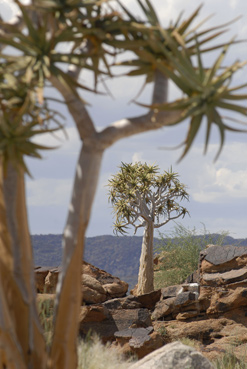
National parks offer visitors an unparalleled diversity of adventure tourism opportunities including game viewing, bush walks, canoeing and exposure to cultural and historical experiences.
Fifteen of South Africa’s 21 national parks offer park or camp-run accommodation. Most parks and rest-camps have retail facilities and restaurants. Across the parks, there are a total of 6 000 beds and 1 000 camping and caravan sites, which can accommodate almost
12 000 overnight guests.
There are various park clusters:
- the Kruger Park
- the arid cluster
- the Cape cluster
- the frontier cluster
- the Garden Route cluster
- the northern cluster
The Kruger National Park is characterised by combinations of savannah, thornveld and woodland eco-zones.
The arid cluster is characterised by arid climate, sparse vegetation and sandy soils, and consists of parks in the Northern Cape – Augrabies Falls, Namaqua, Kgalagadi Transfrontier, Mokala and |Ai-|Ais / Richtersveld. In 2007, Unesco proclaimed the Richtersveld Cultural and Botanical Landscape to be a World Heritage Site.
Cape cluster parks – those within the south-western reaches of the Western Cape – are home to the endemic Cape Floral Region, also a World Heritage Site. They also feature mountainous, coastal, riverine or estuarine habitats. They are the Bontebok, Table Mountain, Tankwa Karoo, Agulhas and West Coast national parks.
The frontier cluster is located in the frontier regions of the Eastern Cape and includes a variety of habitats across the parks, ranging from Nama-Karoo, grassland, montane, forest, valley thicket, fynbos and coastline. Addo, Karoo, Camdeboo and Mountain Zebra National Parks fall in this cluster.
The Garden Route cluster lies in the picturesque Garden Route on South Africa’s southern coast, and features a range of habitats including rocky shorelines, temperate forests, lakes, rivers, estuaries and fynbos. Tsitsikamma and Wilderness fall into this cluster, as well as the Knysna Marine Protected Area.
The northern cluster features savannah, thornveld or grasslands, located in the northern provinces of South Africa. Mountains are a feature of some. Golden Gate, Mapungubwe and Marakele fall into this cluster. Mapungubwe is also the location of another Unesco World Heritage Site.

Addo Elephant National Park
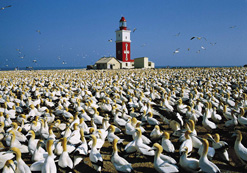
Deep within the shadows of the dense bushveld of the Sundays River region of the Eastern Cape lies the Addo Elephant National Park. Originally proclaimed in 1931 with only 11 elephants, today this finely tuned ecosystem is sanctuary to over 450 of the animals – the densest elephant population on earth. Other wildlife includes the Cape buffalo, black rhino, a variety of antelope species, as well as the unique flightless dung beetle, found almost exclusively in Addo.
A unique combination of the Big Seven – elephant, rhino, lion, buffalo, leopard, whales and great white sharks – makes the park a major attraction, as does its rich heritage of archaeological and historical sites. The park also contains five of South Africa’s seven major vegetation zones.
Future plans include the proposed proclamation of a 120 000ha marine reserve to include islands that are home to the world’s largest breeding populations of Cape gannets and second largest breeding population of African penguins. This reserve also incorporates the largest coastal dune field in the southern hemisphere.
Plans are being implemented to expand the 164 000-hectare Addo into a 360 000-hectare mega-park.
- Year proclaimed: 1931
- Current size: 1 642.3 square kilometres
- Province: Eastern Cape

Agulhas National Park
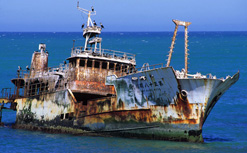
Cape Agulhas is the southernmost tip of Africa, at 34° 49′ 58″ south and 20° 00′ 12” east, a point marked with a cairn. Found in the Western Cape, the park captures the adventure of sailing around the tip of the continent, crossing from the Atlantic to the Indian Ocean.
The Agulhas area contains representatives of unique vegetation such as limestone fynbos. Although most species bloom between May and September, there are flowers to be enjoyed in any season.
Among the mysteries associated with this region is the legendary Cape of Storms, which wrecked many ships en route to the east via Cape Agulhas. Shipwrecks dot the coastline – of the Zoetendal, Birkenhead and Armiston – with key artefacts from the vessels on display at the Bredasdorp Shipwreck Museum.
Ancient people also left their mark on the landscape. Archaeological middens indicate a successful hunter-gathering culture in harmony with its natural environment, and a cultural heritage that dates back thousands of years to when the Khoi-Khoi people trapped fish using ingeniously constructed tidal traps.
The remains of ancient stone fish traps can be seen to the east of the Cape Agulhas lighthouse, the second-oldest working lighthouse in southern Africa, which houses a unique lighthouse museum.
- Year proclaimed: 1999
- Current size: 56.9 square kilometres
- Province: Western Cape
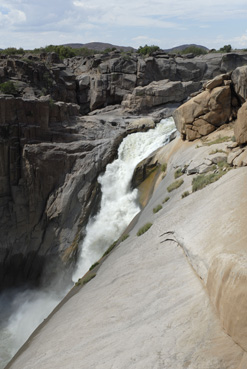
Few sights are as awesome or a sound as deafening as water thundering down the 56m Augrabies waterfall when the Orange River is in full flood.
The Khoi people called it “Aukoerebis”, or place of Great Noise, as this powerful flow of water is unleashed from rocky surroundings characterised by the 18km abyss of the Orange River gorge in the far Northern Cape.
Picturesque names such as Moon Rock, Ararat and Echo Corner are descriptive of this rocky region.
Klipspringer and kokerboom (quiver trees) stand in stark silhouette against the African sky, silent sentinels in a strangely unique environment where only those that are able to adapt ultimately survive.
The 55 383ha on both the northern and southern sides of the Orange River provide sanctuary to a diversity of species, from the smallest succulents, birds and reptiles to springbok, gemsbok and giraffe.
The black stork and pygmy falcon are among the special birds in the park.
- Year proclaimed: 1966
- Current size: 416.7 square kilometres
- Province: Northern Cape
Bontebok National Park
Bontebok National Park in the Western Cape is a place of beauty and peaceful charm, set against the majestic Langeberg Mountains. A part of the Cape Floral Region World Heritage Site, the park always offers something in bloom.
The park boasts proud achievements in biodiversity conservation, from the endangered fynbos veld type, coastal renosterveld, to the namesake bontebok. Once these colourful antelope numbered a mere 17, now the population sits at around 3 000. The park also offers bird watchers over 200 bird species.
- Year proclaimed: 1931
- Current size: 27.9 square kilometres
- Province: Western Cape
Camdeboo National Park
Formed hundreds of millions of years ago, the Karoo is one of the great natural wonders of the world. Camdeboo National Park provides the visitor with insights into the unique landscape and ecosystem, not to mention awesome scenic beauty.
A unique feature of the 14 500ha park is its location, practically surrounding the historic town of Graaff-Reinet in the Eastern Cape.
Most of the park lies up against the foothills of the Sneeuberg range, with the Nqweba Dam within the park. At some places, dolerites form jointed pillars – the best examples of which are found in the Valley of Desolation where erosion of the softer sedimentary beds has left dolerite pillars which rise to heights of 90m to 120m.
- Year proclaimed: 2005
- Current size: 194 square kilometres
- Province: Eastern Cape

Golden Gate Highlands National Park
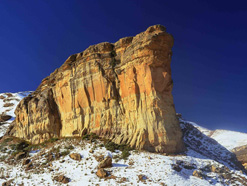
Nestled in the rolling foothills of the Maluti Mountains of the north eastern Free State lies the Golden Gate Highlands National Park.
The park derives its name from the brilliant shades of gold cast by the sun on the park’s sandstone cliffs.
This 11 600ha of unique environment is true highland habitat, providing home to a variety of mammals – black wildebeest, eland, blesbok, oribi, springbok and Burchell’s zebra – and birds, including the rare bearded vulture (lammergeier) and the equally rare bald ibis, which breed on the ledges in the sandstone cliffs.
- Year proclaimed: 1963
- Current size: 116.3 square kilometres
- Province: Free State
Karoo National Park
The Great Karoo is a vast and unforgiving landscape of which the Karoo National Park is but a small portion. Being the largest ecosystem in South Africa, the Karoo is home to a fascinating diversity of life, all having adapted to survive in harsh conditions.
The Karoo National Park is dominated by the lofty Nuweveld Mountains and rolling plains, with a wide variety of wildlife. Many species have been relocated to their former ranges, such as black rhino and buffalo, as well as Cape mountain zebra. Over 20 breeding pairs of black eagle find sanctuary within the park. There is also a wide diversity of succulent plants and small reptiles.
The park has five species of tortoise, the highest density of species per equivalent area anywhere in the world. The Cape mountain zebra is well established in the park and visitors have the opportunity to compare its bold stripe pattern to that of the extinct quagga.
The springbok – the emblem of the park and present in high numbers – is a reminder of the once massive herds that crossed the Karoo on annual migration, leaving a trail of devastation.
The Klipspringer Mountain Pass not only provides visitors with spectacular views, but is also an example of civil engineering toil and precision.
- Year proclaimed: 1979
- Current size: 831.3 square kilometres
- Province: Western Cape
Kgalagadi Transfrontier Park
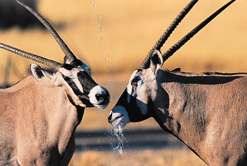
The Kalahari Gemsbok National Park in the far Northern Cape was proclaimed in 1931 to protect migrating game, especially the gemsbok. Together with the adjacent Gemsbok National Park in Botswana, this park comprises an area of over 3.6-million hectares, consisting of red sand dunes, sparse vegetation, imposing camel thorn trees and dry riverbeds.
It is nearly twice the size of the Kruger National Park, and the first Transfrontier Park to be established in Africa.
Kgalagadi is the first park to provide accommodation in three wilderness camps that, with no fences, invite the Kalahari and the tranquillity of Africa right into your room. The name “‘Kgalagadi” is derived from the San language and means “place of thirst”.
Wildlife to look for in particular includes gemsbok, black-maned Kalahari lions and birds of prey.
- Year proclaimed: 1931
- Current size: 9 591 square kilometres (South African section)
- Province: Northern Cape
Knysna National Lake Area
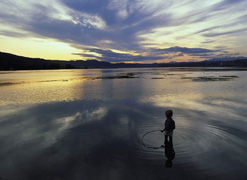
Knysna nestles on the banks of a beautiful lagoon in the heart of the Garden Route, in the Cape. It is surrounded by a natural paradise of lush indigenous forests, tranquil lakes and golden beaches.
The exceptionally beautiful Knysna National Lake Area is home to the endangered Knysna seahorse and a large diversity of marine life. Sandbanks and salt marshes teem with life and in turn provide food to an immeasurable number of organisms.
Dominated by the craggy bastions of the twin Knysna Heads, the lagoon has borne witness to centuries of trade in timber, ivory and gold.
As a result of a relaxed lifestyle, Knysna has over the years, attracted a wide variety of art and crafters, creating an artists’ paradise. One of the last single gauge operational steam trains in the world travels between Knysna and George, called the Outeniqua Choo-Tjoe.
A speciality of the area is oysters. They are cultivated in the Knysna Lagoon and served in most of the local restaurants. The Knysna Oyster Company, established in 1949, is situated on Thesen Islands and offers daily educational tours, accompanied by fine cuisine.
- Year proclaimed: 1985
- Current size: 150 square kilometres
- Province: Western Cape
Kruger National Park
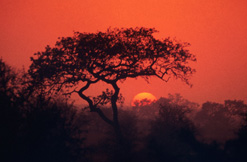
The world-renowned Kruger National Park offers a wildlife experience that ranks with the best in Africa. Established in 1898 to protect the wildlife of the Lowveld, this national park of nearly 2 million hectares is unrivalled in the diversity of its life forms and a world leader in advanced environmental management techniques and policies.
Truly the flagship of the South African national parks, Kruger is home to an impressive number of species: 336 trees, 49 fish, 34 amphibians, 114 reptiles, 507 birds and 147 mammals.
Man’s interaction with the Lowveld environment over many centuries – from bushman rock paintings to majestic archaeological sites like Masorini and Thulamela – is very evident in the Kruger National Park. These treasures represent the cultures, persons and events that played a role in the history of the park and are conserved along with the park’s natural assets.
The park has 13 rest camps, 11 bushveld camps, and 11 lodges.
- Year proclaimed: 1898 (officially proclaimed in 1926)
- Current size: 19 623.6 square kilometres (slightly smaller than Israel)
- Provinces: Mpumalanga and Limpopo
Mapungubwe National Park
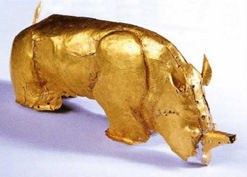
Mapungubwe National Park in Limpopo is rich in biodiversity, great scenic beauty and the cultural importance of the archaeological treasures of Mapungubwe. From a hilltop on the northern edge of the park the visitor can view the confluence of the legendary Limpopo and Shashe Rivers, as well as two neighbouring countries: Botswana and Zimbabwe.
The park is the site where a developed African civilisation prospered between 1000 and 1290 AD. The area was already inhabited by a growing Iron Age community from 900 AD and became rich through trade with faraway places like Egypt, India and China. This is the place where archaeologists excavated the famous golden rhino and other evidence of a wealthy African kingdom.
Sandstone formations, mopane woodlands and unique riverine forest and baobab trees add to the experience. Impressive Khoi/San rock art shelters have also been uncovered.
Elephant, giraffe, white rhino, eland, gemsbok and numerous other antelope species occur naturally in the area. Predators include lions, leopards and hyenas. Birds to tick off the list include the kori bustard, tropical boubou and Pel’s fishing owl.
- Year proclaimed: 1989
- Current size: 53.6 square kilometres
- Province: Limpopo
Marakele National Park
The Marakele National Park in the heart of the Waterberg Mountains in Limpopo, as its Tswana name suggests, has become a “place of sanctuary” for an impressive variety of wildlife due to its location in the transitional zone between the dry western and moister eastern regions of South Africa. Contrasting majestic mountain landscapes, grass-clad hills and deep valleys characterise the park.
Rare finds of yellowwood and cedar trees, five-metre high cycads and tree ferns, are some of the plant species found here. All the large game species from elephant and rhino to the big cats as well as an amazing variety of birds including what’s probably the largest colony of endangered Cape vultures (more than 800 breeding pairs) in the world, have settled here.
A narrow tar road takes visitors up to the top of the Waterberg massif, where the views and scenery are spectacular. From this height vultures soar past at close quarters.
Antelope species such as reedbuck, mountain reedbuck, eland and tsessebe can be found in the park.
- Year proclaimed: 1993
- Current size: 507.3 square kilometres
- Province: Limpopo
Mokala National Park
Mokala is one of the country’s newest parks, situated in the far eastern corner of the Northern Cape. It comprises 19 611 hectares of Kalahari thornveld, savannah and Nama Karoo terrain interspersed with rocky outcrops, and with a wetland area that stretches for 18 kilometres.
Mokala is a Setswana name for a Camel Thorn, an incredible resource to wildlife who survive in often harsh conditions characteristic of this area. Many animals have been relocated to the park and include black and white rhino, tsessebe, roan antelope, red hartebeest, buffalo, gemsbok and black wildebeest.
- Year proclaimed: 2007
- Current size: 196.1 square kilometres
- Province: Northern Cape
Mountain Zebra National Park

The Mountain Zebra National Park, near Cradock in the Eastern Cape, is a conservation success story, saving the Mountain Zebra species from extinction. In 1937 when the park opened it had only six zebra on 1 712ha of land. These zebra didn’t survive but donations by local farmers ensured the species and the park continued. Today it boasts 370 zebra roaming in 28 412ha, kept company by black rhino, eland, black wildebeest, red hartebeest and Cape buffalo.
In the craggy heights of the park lurk grey rhebok. Caracal and cheetah are the predators of the park. Birds to look out for are the blue crane and Stanley’s bustard.
- Year proclaimed: 1937
- Current size: 284.1 square kilometres
- Province: Eastern Cape
Namaqua National Park
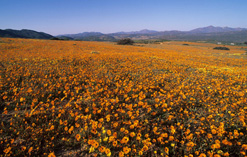
You’ll know when you’re in the Namaqua National Park – a tapestry of brilliant colours unfolds enticingly along the winding roads in August and September. Butterflies, birds and long-tongued flies dart around among the flowers, seemingly overwhelmed by the abundance and diversity.
With its winter rainfall, Namaqualand is home to the richest bulb flora of any arid region in the world and more than a 1 000 of its estimated 3 500 plant species are found nowhere else on earth. Fields of flowers, star-studded nights, quiver trees, enormous granite outcrops and the icy Atlantic are just some of the sights to catch.
The Namaqua National Park is on the western edge of the Northern Cape, in the world’s only arid biodiversity hotspot, and is home to the world’s smallest tortoise, the Namaqua speckled padloper.
- Province: Northern Cape

Table Mountain National Park
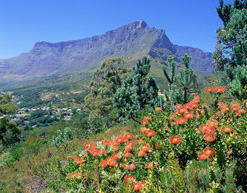
The Table Mountain National Park encompasses the incredibly scenic Table Mountain Chain stretching from Signal Hill in the north to Cape Point in the south and the seas and coastline of the peninsula. It is one of the country’s natural World Heritage Sites.
The narrow finger of land with its beautiful valleys, bays and beaches is surrounded by the waters of the Atlantic Ocean in the west and the warmer waters of False Bay and has within its boundaries two world-renowned landmarks – majestic Table Mountain and the legendary Cape of Good Hope.
The park is recognised globally for its extraordinarily rich, diverse and unique fauna and flora – with rugged cliffs, steep slopes and sandy flats. Nowhere else in the world does an area of such spectacular beauty and such rich bio-diversity exist almost entirely within a metropolitan area – the thriving and cosmopolitan city of Cape Town.
- Year proclaimed: 1998
- Current size: 243.1 square kilometres
- Province: Western Cape
Tankwa Karoo National Park
The 80 000 hectare Tankwa Karoo National Park, proclaimed in 1986, protects one of the most starkly beautiful tracts of the Tankwa Karoo and is worth visiting for its koppie-studded, moon-like landscape, diversity of succulent plants, fine Karoo birding, in particular the enigmatic Burchell’s courser. A dense population of black eagle breeding pairs is also found in the park.
Situated on the southern boundary of the Northern Cape, between the Roggeveld Escarpment in the east, Cedarberg in the west, and Klein Roggeveldberge in the south, the park erupts into a dazzling display of flowering succulents after a shower.
Only two southern African regions have been designated as Biodiversity Hotspots by Conservation International. One is the Cape Floral Kingdom, and the other the Succulent Karoo, of which Tankwa is part.
There is no tourism infrastructure in the park, although there are a couple of privately operated B&Bs on the periphery of the park. There are three very historical houses offering only a roof to stay under and drinking water close by. Entrance to the park is at the discretion of park management.
- Year proclaimed: 1986
- Current size: 439 square kilometres
- Province: Northern Cape
Tsitsikamma National Park
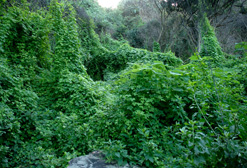
The Tsitsikamma National Park, “the place of much water”, consists of forest, fynbos, rivers and a five-kilometre stretch into the sea, on the eastern border of the Western Cape.
It protects inter-tidal life, reef and deep-sea animal life, which include dolphins, porpoises and the African black oystercatcher, a red data species of bird. The Cape clawless otter resides along the park’s coastline and rivers.
The Knysna loerie and the miniature blue duiker can be seen in the forest.
- Year proclaimed: 1964
- Current size: 639.4 square kilometres
- Province: Western Cape
West Coast National Park

Just inland from the secluded harbour of Saldanha Bay in the Western Cape are the azure waters of the Langebaan Lagoon, focal point of the West Coast National Park. Thousands of seabirds roost on sheltered islands, pristine golden beaches stretch endlessly into the early morning mist and brooding salt marshes are home to vast concentrations of migrant waders, including the cape gannet, the jackass (African) penguin, flamingos, and the black harrier, from the northern hemisphere.
During the spring the strandveld is filled with a tapestry of multi-hued flowers, while in the Postberg section many antelope are to be seen in a setting that is as unique as it is idyllic.
- Year proclaimed: 1985
- Current size: 362.7 square kilometres
- Province: Western Cape
Wilderness National Park
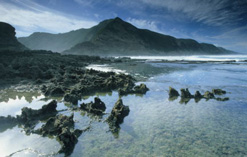
In the heart of South Africa’s famous Garden Route, a captivating world of lakes, rivers, estuaries and beaches unfolds against a backdrop of lush forest and lofty mountains – all elements that characterise the Wilderness National Park.
Wilderness National Park stretches from the Touw River mouth to the Swartvlei estuary and beyond, where it links with the Goukamma Nature Reserve.
Nature trails wind through densely wooded forest and along tranquil rivers, affording you the opportunity to encounter the brilliantly coloured Knysna loerie, or one of the five kingfisher species that occur here. During spring, a carpet of flowers further enhances the verdant beauty of this national park.
Whales and dolphins can be spotted from Dolphin Point. Or, look out for the Knysna seahorse, the pansy shell, the pied kingfisher, the grey heron and the little egret.
- Year proclaimed: 1985
- Current size: 1 060 square kilometres
- Province: Western Cape
|Ai-|Ais / Richtersveld Transfrontier National Park
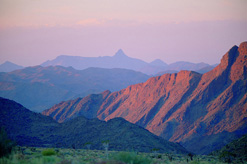
A desolate and forbidding landscape belies the fact that the Richtersveld has the world’s richest desert flora. Miniature rock gardens, perfectly designed by nature, cling precariously to cliff faces. Tiny succulents, mere pinpoints against a backdrop of surreal rock formations, revel in the moisture brought by the early morning fog rolling in from the cold Atlantic Ocean.
Rugged kloofs, high mountains and dramatic landscapes that sweep away inland from the Orange River give way to the vast mountain desert that is the |Ai-|Ais/Richtersveld National Park, an area managed jointly by the local Nama people and the South African National Parks.
A staggering assortment of plant life, some species occurring nowhere else, is to be found here, with gnarled quiver trees, tall aloes and the tall “half-mens” plant keeping vigil over this inscrutable landscape.
Animals to look out for are the rock hyrax, jackal buzzard and the Hartmann’s Mountain Zebra.
The park is only accessible by 4×4 vehicles or vehicles with high clearances.
- Province: Northern Cape
Source: www.mediaclubsouthafrica.com
